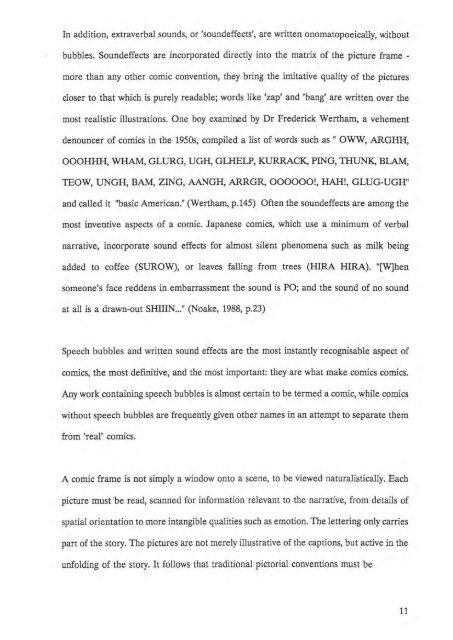Text - Rhodes University
Text - Rhodes University
Text - Rhodes University
Create successful ePaper yourself
Turn your PDF publications into a flip-book with our unique Google optimized e-Paper software.
In addition, extraverbal sounds, or 'soundeffects', are written onomatopoeically, without<br />
bubbles. Soundeffects are incorporated directly into the matrix of the picture frame -<br />
more than any other comic convention, they bring the imitative quality of the pictures<br />
closer to that which is purely readable; words like 'zap' and 'bang' are written over the<br />
most realistic illustrations. One boy examin.ed by Dr Frederick Wertham, a vehement<br />
denouncer of comics in the 1950s, compiled a list of words such as " OWW, ARGHH,<br />
OOOHHH, WHAM, GLURG, UGH, GLHELP, KURRACK, PING, TIIUNK, BLAM,<br />
mow, UNGH, BAM, ZING, AANGH, ARRGR, OOOOOO!, HAH!, GLUG-UGH"<br />
and called it "basic American." (Wertham, p.145) Often the soundeffects are among the<br />
most inventive aspects of a comic. Japanese comics, which use a minimum of verbal<br />
narrative, incorporate sound effects for almost silent phenomena such as milk being<br />
added to coffee (SUROW), or leaves falling from trees (HIRA HIRA). "[W]hen<br />
someone's face reddens in embarrassment the sound is PO; and the sound of no sound<br />
at all is a drawn-out SHIIIN ..." (Noake, 1988, p.23)<br />
Speech bubbles and written sound effects are the most instantly recognisable aspect of<br />
comics, the most definitive, and the most important: they are what make comics comics.<br />
Any work containing speech bubbles is almost certain to be termed a comic, while comics<br />
without speech bubbles are frequently given other names in an attempt to separate them<br />
from 'real' comics.<br />
A comic frame is not simply a window onto a scene, to be viewed naturalistically. Each<br />
picture must be read, scanned for information relevant to the narrative, from details of<br />
spatial orientation to more intangible qualities such as emotion. The lettering only carries<br />
part of the story. The pictures are not merely illustrative of the captions, but active in the<br />
unfolding of the story. It follows that traditional pictorial conventions must be<br />
11
















